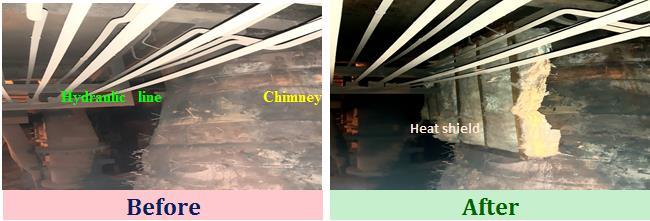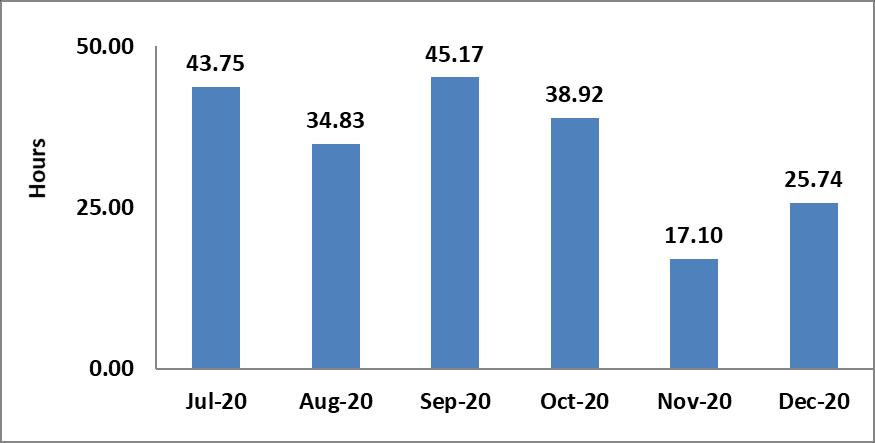
8 minute read
Defect/ rework loss Losses due to defect and reworking
from IRJET- Embellishing TPM through Losses Analysis to Enhance Overall Plant Effectiveness in Ferro
Volume: 08 Issue: 03 | Mar 2021 www.irjet.net p-ISSN: 2395-0072
causes of theselosses. Availability takes equipment failure and setup & adjustment losses into account. Likewise, the focused improvement is going to be used to address the causes of these losses.
Advertisement
Below is few major kaizensand best practices adoptedas solutions to minimize / eliminate these losses.
Problem 1: Due to high temperatures in the furnace, stainless steel pressure rings got cracked frequently and resulting water leakages.
The Why-why analysis:
1. Why the Pressure ring water leakage occurs? - Due to heavy heat radiation, the SS ring got cracked and leaked. 2. Why the heatradiation is high? -Due to over rating of furnace and high ash coal usage the heat radiation is high at the furnace topand SS rings are not protected from radiation. 3. Why the pressure rings arenot protected from heat? -The pressure ring can be protected from heat radiation by covering with aninsulation material.
Kaizen performed:
Kaizen Theme: To minimize the furnace delay due to water leakages in pressure ring. Idea: By insulating the pressure ring with anchors and castable. Countermeasure / Solution: Water leakages can be minimized by insulating the pressure ring with anchors and castable. By this the direct heat radiation can be minimized. So castable provided on pressure ring as shown in Fig-4.
Fig -4 : Before and After
Problem 2:Due to heat radiation the hydraulic pipeline was frequentlyfailing.
The Why-why analysis:
1. Why temperatures of hydraulic power pack getting high? Answer: Due to heating of hydraulic line from heat radiation ofchimney. 2. Why hydraulic line getting heat from chimney heat radiation? Answer:Due to lack of a heat shield in between chimney and hydraulic pipeline. 3. Why heat shield was not there? Answer: Because earlier temperature was low in furnace due to good quality of raw materials (coal), thereforeno need of heat shield at that time.
Kaizen performed:
Kaizen Theme: Provision of heat shield between hydraulic pipelines to chimney to avoid heat radiation. Idea: Arrangement of a heat shield to protect hydraulic pipelinefrom chimneysheat radiation. Countermeasure/ Solution: A heat shield of glass wool materials prepared and fixed in between chimney and hydraulic line to protect hydraulic line from heat radiation of chimneyas shown in Fig-5.

Fig -5: Before and After
Apart from the mentioned kaizens, several other kaizens had been performed and many best practices have been adopted to eliminate / minimized the losses.
5.4 Result & Discussion:
After problem analysis and successfully implementation of all solutionsin form of Kaizens and best practices adopted, again data of OPE and losses are collected for 6 moths (July 2020 to December 2020)as shown in Table-3.
Month Availabi lity (%) Perform ance Rate (%) Quality Rate (%) OPE (%)
Jul-20 94.12 91.60 100 86.21 Aug-20 95.32 90.55 100 86.31 Sep-20 93.73 93.26 100 87.41 Oct-20 94.77 93.09 100 88.22 Nov-20 97.63 91.05 100 88.89 Dec-20 96.54 94.89 100 91.60 Table-3: Data collection after implementation
Volume: 08 Issue: 03 | Mar 2021 www.irjet.net p-ISSN: 2395-0072
It is evident from the Table-3 that availability and performance rate is now consistent which resulted in higher OEEvalueswhich are well above thestandard value of OEE in world (85%).
Data of the mentioned losses were again collected for the period of next 6 months (after implementation of KK Kaizens, etc.) as month wise total losses in Chart-4. The comparative data (before and after implementation of TPM philosophy successfully) of total losses, monthly avg. losses, total losses in 6 months (loss wise)as well as % OEEhas been depicted in Charts 4-8respectively.
Chart -4: Total lossesin hours (month wise)
Chart -5: Total losses (Before and After) Chart-6: Monthly avg. losses (Before and after)
Chart-7: Losses in 6 months(loss wise)





Chart-8: %OEE(Before and After)
It is evident from these charts that after detailed analysis of losses, after implementation of several kaizens and best practices adopted under the focused improvement (KK Pillar) alltypes of losses havebeen decreaseddrastically.However,
Volume: 08 Issue: 03 | Mar 2021 www.irjet.net p-ISSN: 2395-0072
some more attention are required to make these losses zero which is the ultimate goal of TPM.
It is clear from the charts that losses have been decreased up to 170.52 hour from the previous level of 476.06 hours. Whereas monthly avg. losseshavebeen reduced up to a level of 28.42 hours from previous 79.34 hours. During these 6 months, equipment failure loss is decreased from 355.94 hours to 126.82 hours in 6 months.There are increasesin availability and performance rate as the OPE has been increased by 29.6% and reached to a level of 88.1% (earlier it was 69.42%).
6. CONCLUSIONS
The successful improvement of OEE depends on the elimination of 16 types of losses through Kobestu Kaizen (focussed improvement). The key factors for this implementation are workers involvement and top management support. To improve productivity, it is essential to improve the performance of the manufacturing systems. The desired production outputis achieved through high equipment availability, which is influenced byequipment reliability and maintainability. OEE is a structured continuous improvement process that strives to optimize production effectiveness by identifying and eliminating losses associated with equipment and production efficiency throughout the production system life cycle through active team-based involvement of employees across all levels of the operational hierarchy by performing kaizens and adoptions of best practices. The average value ofOPE of SAF Plant was 69.43% with an availability of 82-83%,performance rate 82-86%, and qualityrate 100%. OPEvalues of the plant was below the standard OEE value in the world, which is 85%. The main factor influencing the low OEE value is the equipment failure with a percentage of 75%. Other factors that cause losses are 22% (idle and minor stoppage) and 3% (shutdown losses). After the detailed analysis of losses, considering suitable corrective actions in form of focused improvement kaizens and adoption of best practices would eliminate / stop the losses and increase OPE / OEE drastically. It is expected that this study would help people to visualize and understand the losses elimination and would help the industries more productive.
REFERENCES
[1] Nakajima, S., Introduction to Total Productive
Maintenance (TPM), Productivity Press, Portland, 1988. [2] Chaneski, W.S., Total productive maintenance – an effective technique, Modern Machine Shop, Vol. 75, No. 2, pp. 46-48, 2002. [3] Dr. Manish Raj, Shubham Swaroop, Saureng Kumar,Raj
Bhushan, Vikalp Kumar, M G Borkar, Kobetsu Kaizen
Losses Analysis to Enhance the Overall Plant
Effectiveness in Steel Manufacturing Industry–A Case
Study at JSPL, Raigarh, International Research Journalof
Engineering and Technology (IRJET), Vol. 4, Issue: 12, pp-245-251, 2017. [4] Dr. Manish Raj, Pintu Kumar, Raj Bhushan, Vikalp
Kumar, M G Borkar, Effective Implementation of Planned
Maintenance in a Gas ProducingPlant: A Case Study at
JSPL, Raigarh, International Research Journal of
Engineering and Technology (IRJET), Vol. 5, Issue: 12, pp-732-740, 2018. [5] Suzuki, T. (1994), TPM in Process Industries,
Productivity Press Inc., Portland, OR [6] Lisbeth del Carmen Ng Corrales, María Pilar Lambán ,
Mario Enrique Hernandez Korner and Jesús Royo,
Overall Equipment Effectiveness: SystematicLiterature
Review and Overview ofDifferent Approaches, Appl. Sci. 2020, 10, 6469; doi:10.3390/app10186469. [7] Lauri Ho Jappa and Seppo Louhenkilpi, ON THE ROLE OF
FERROALLOYS IN STEELMAKING, The thirteenth
International Ferroalloys Congress Efficient technologies in ferroalloy industry.
Japan_Institute_of_Plant_Maintenance, 1996. [8] Kobetsu Kaizenmanual, TPM Club of India. [9] Chetan Patel and Vivek Deshpande, A Review on
Improvement in Overall Equipment Effectiveness,
International Journal for Research in Applied Science &
Engineering Technology (IJRASET),Volume 4,Issue XI,
November 2016, pp642-650. [10] AshokKumar.A, “Implementation of overall equipment effectiveness (OEE)”, International Journal of
Engineering Trends and Technology (IJETT), Volume2, issue3,Number 1, Nov2011. [11] Pavan Kumar Malviya, Ravi Nagaich, “Enhancing the
Overall Equipment Effectiveness through Total
Productive Maintenance in SME”, InternationalJournal of Research in Engineering Technology and
Management, ISSN 2347 –7539, Volume: 03, Issue: 04,
July-2015. [12] Mohammed Asif Mulla, Ramesh C.G, “Enhancing Overall
Equipment Effectiveness of HMC Machines Through
TPM and 5S Techniques in a ManufacturingCompany”,
International Journal on Mechanical Engineering and
Robotics (IJMER), Volume-2, Issue-2, 2014. [13] M. Vivek Prabhu, R. Karthick, Dr. G. Senthil Kumar,
“Optimization of Overall Equipment Effectiveness in A
Manufacturing System”, International Journal of
Innovative Research in Science, Engineering and
Technology, Volume 3, Special Issue 3, March 2014. [14] Amit Kumar Gupta, Dr. R. K. Garg, “OEE Improvement by
TPM Implementation: A Case Study”, International
Journal of IT, Engineering and Applied Sciences
Research, ISSN: 2319-4413 Volume 1, No. 1, October 2012.
Volume: 08 Issue: 03 | Mar 2021 www.irjet.net p-ISSN: 2395-0072
BIOGRAPHIES
Dr. Manish Raj has completed his Ph. D. in Material Science. He has an industrial experience of more than 30 Years in the field of TQM, TPM, Quality, ISO, NonDestructive Testing and Evaluation, Conditional Monitoring, etc.
Mr. Raj Bhushan has completed his M. Tech.degree in Industrial Engineeringand Management. Hehas industrial experience of more than 8 Years in the field of Industrial Engineering, TQM, TPM, ISO, etc.
Mr. KVKS Prakash having more than 16 years’ experience in the field of ferro alloys production planning and working as Manager in JSPL-Raigarh leading technical cell in ferro alloys division. He holds dual PG in Masters in Material science & metallurgy and MBA in Operations & Finance.
Mr. Vikalp Kumar completed his BCA degree in 2004. He has industrial experience of more than13 Years in the field of TPM, TQM,ISO, etc.
Mr. Barla Appalaraju is having morethan 30 years’ experience in the ferro alloys field and presently working as Vice President in M/s JSPL-Raigarh leading ferro alloys & industrial gases division. He is a post-graduate in Material Science and Metallurgy and a research scholar in solid waste utilization in steel industries.
Mr. Moreshwar G Borkar has completed his B.E. in Metallurgy. He has an industrial experience of more than 26 Years in the field of Quality, R&D, Product Development, etc. He is Heading TSD & TQM Dept. at JSPL, Raigarh.



